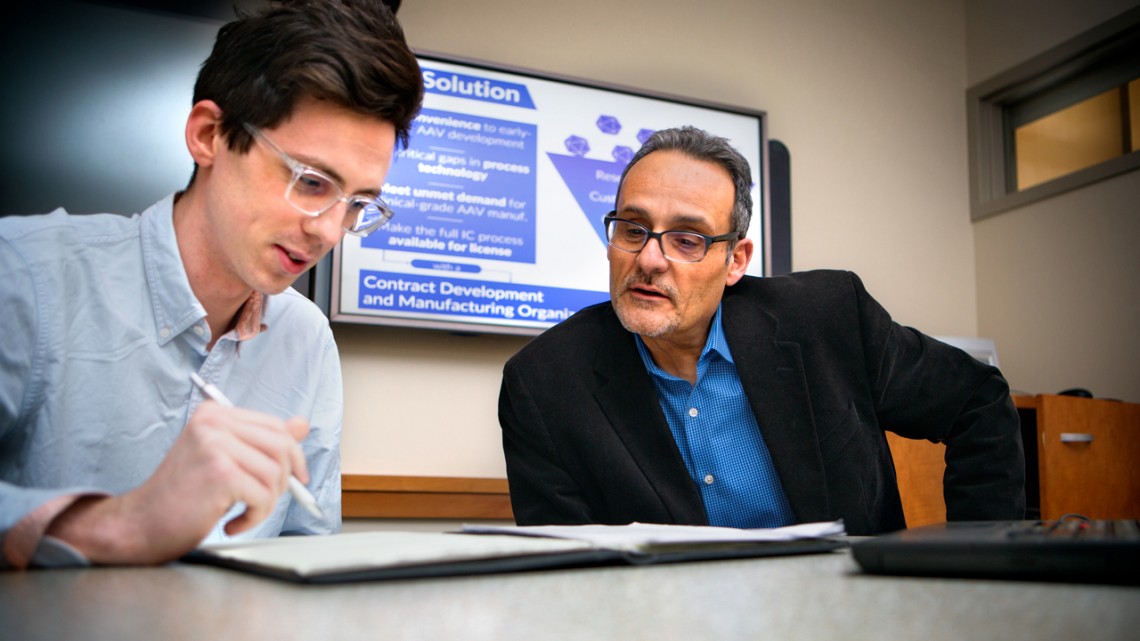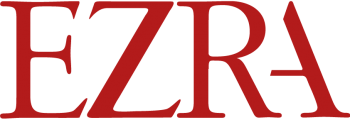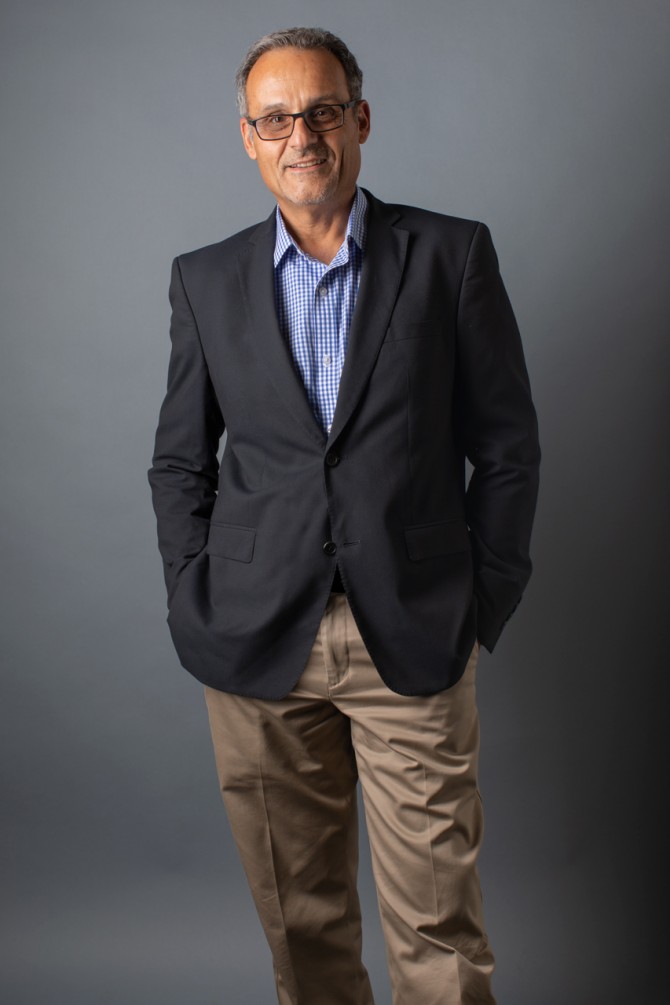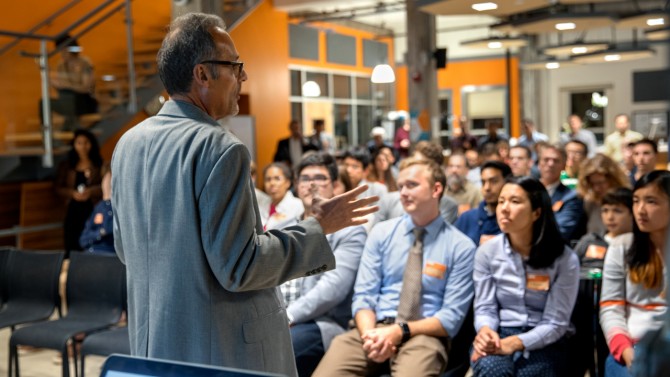
Emmanuel Giannelis, right, confers with materials science and engineering Ph.D. candidate William Bedell in 2017.
Vice provost is building culture of entrepreneurship and innovation
By Joe Wilensky
Emmanuel Giannelis is the Walter R. Read Professor of Engineering and has served as Cornell’s vice provost for research and vice president for technology transfer, intellectual property and research policy since July 2017.
With a mission of advancing and supporting Cornell research, entrepreneurship and technology commercialization, Giannelis’ office also promotes research and innovation across Cornell’s Ithaca and NYC campuses.
You’ve been in this role for two years; how well is Cornell integrating and promoting research across its campuses?
First of all, let me say it’s really an honor, a privilege, to be a part of the leadership team, and also to represent all these brilliant star faculty members.
In an interesting way, I have two roles – one is vice provost for research, and my portfolio covers the Ithaca campus and Cornell Tech. As vice president for technology transfer, I also oversee all intellectual property (IP), including that which comes out of Weill Cornell Medicine.
One of the challenges is, even though we are distributed geographically, how do we bring these teams closer together? We have strengths in many, many different areas, and bringing them together, and finding those synergies, is actually what distinguishes us from other universities. We have the Ithaca campus, but also, in New York City, we have a medical school and now Cornell Tech – and those kinds of combinations are not the kinds that you find every day with our peer institutions. Leveraging those combinations is actually one of the strengths of Cornell.
What challenges, or surprises, have you found in this position?
The first thing I found – despite my numerous roles in the College of Engineering and being on the faculty since 1987 – was how little I knew about what is going on at Cornell. There are gems all over the place that I was not that familiar with. This job will be a learning experience even as I complete my five-year term.
But it’s not just getting to know the faculty and the research areas; there is also getting to know our staff, including the staff who work with all the research centers in our portfolio. And that’s a large number of people – more than 700.
As I was first thinking about this position and looking at it from the outside, I thought we needed to provide programming that allows our faculty and students to pursue their entrepreneurial interests and also to increase our interactions with industry. What surprised me was that while we have been making progress in providing this new programming (such as the GateWay to Partnership initiative and the Fast Track Startup License program), not all of our faculty, students or potential corporate clients have noticed. So it has been at times harder to market these programs than to establish them.
How important is our interdisciplinary research, and what is Cornell doing to elevate research in the social sciences and humanities?
To have interdisciplinary research, you have to have strong disciplines. When we talk about bringing people from different fields together, it goes without saying that we really care first about the disciplines themselves. So we’re leveraging the strengths in the disciplines by cross-catalyzing collaborations between them.
I come from the physical sciences and engineering fields. I’ve been at Cornell for 32 years, and as a faculty member, I know that within these fields, these cross-collaborations are fairly easy. There is a network of faculty, there are research centers, and it’s natural for faculty to come together and propose new ideas. To an extent this is also true in the life sciences. It will be extremely valuable to bring to the table social scientists and others, and then start approaching these collaborations from even more sides.
I like to think of my portfolio as representing not just research, but research and scholarship. And so I represent not just the physical scientists and engineers and life scientists, but also the social scientists and those in the humanities and in the arts. There are different needs and different challenges, but they are all part of the same portfolio and, since I care about all these fields, I want to represent them and nurture them as well.
Specifically for the social sciences, the provost established review committees, and one of the recommendations that we are implementing right now is creation of the Cornell Center for Social Sciences.
We already have several independent units that are providing research support and promoting interdisciplinary research in the social sciences; we want to bring that all under one umbrella. The new center will comprise all the social sciences units that are part of the vice provost for research portfolio, such as the Cornell Survey Research Institute, the Cornell Institute for Social and Economic Research, the Roper Center for Public Opinion Research, and the Cornell Institute for the Social Sciences. The new structure will allow for more effective deployment of our resources and position our faculty well to seek additional funding from outside sources.
We have named two very accomplished faculty – Sahara Byrne, professor of communication, and Peter K. Enns, associate professor of government and executive director of the Roper Center – as interim co-directors of the center to oversee the activities in the next couple of years and to bring all these efficiencies and synergies together. We’re planning to launch a national search in the summer of 2020 to hire the new director of that center, someone with an international reputation for scholarship and who can help bring in external funding that matches our ambition for the center.
How is the sponsored research landscape changing, and how is Cornell responding collectively as a university?
When you look at the numbers, we do extremely well with federal and New York state funding, especially when it comes to the National Science Foundation and National Institutes of Health. Cornell, as of 2016-17, spends about $1 billion on research each year; we receive nearly $700 million of that annually from federal and state sources.
One of the things we are trying very hard to do is to diversify our research portfolio. If you rely largely on only one or two agencies, a big cut in that particular agency would be felt across many different fields on campus. One goal is to increase funding levels from the Department of Defense, from the Department of Energy, from NASA and from other agencies; we are also working with industry and trying to increase the research dollars that are coming directly from corporations.
What should alumni know about how tech transfer at Cornell is generating new businesses and opportunities?
We are in a transition mode – not only here at Cornell but at many other academic institutions. It used to be that tech transfer offices would secure, and then license, IP.
The new way of doing business, the new model, is to promote new company formation. That means creating new companies, new startups, as a way to monetize the IP portfolio and as an engine of economic development. The new model requires different skills and different strategies.
Another aspect involves working with students and faculty to help them understand what it takes to commercialize their technological innovations.
We are trying to create the conditions and provide resources that allow faculty and students, as well as entrepreneurs from outside Cornell, to use this technology and create successful companies.
How is the entrepreneurial promise of centers and incubators on campus, such as the Praxis Center for Venture Development and the Kevin McGovern Family Center for Venture Development in the Life Sciences, being realized?
Having incubators – and even having post-incubator space, which is something we haven’t quite addressed yet at Cornell – is all part of building a supportive entrepreneurial ecosystem.
To succeed, this ecosystem needs not only the right talent and innovative research, but also the right culture, policy and resources, including investment funding, mentoring and other support systems. Not only do you have to have the right structures in place, but you need to support the culture – basically making innovation and entrepreneurship, including social entrepreneurship, part of our value system.
For example, Cornell Tech articulated entrepreneurship as one of its values from the beginning – it’s right up front; you can’t miss it. What we have in Ithaca is more of a work in progress, as we are building the ecosystem. Working toward the right culture is an important element of that – so are the incubators, and so is the talent.
Another part of that culture is getting our students and postdocs more involved in these activities. By becoming involved, they are really exposed to innovation and entrepreneurship that can serve them well in the future.
Whether they go on to start a new company or whether they join a big established corporation, they will come in with that innovator and entrepreneurial mindset, and that will make them way more competitive to recruiters when the time comes to be hired – as well as more successful in their careers.
How have you extended ways to use research as part of the educational experience for Cornell’s Ph.D. students and postdocs?
I’m borrowing a concept from David Erickson, former associate dean for research and graduate studies in the College of Engineering and currently the S.C. Thomas Sze Director of the Sibley School of Mechanical and Aerospace Engineering, who uses the “E to E” model – education to enterprise. So instead of looking at individual silos that represent education, research, tech transfer and enterprise, now we envision those areas as a continuous circle, and that circle goes from education to research to tech transfer to enterprise and around and around. To me, this “knowledge for a public purpose” concept represents a more holistic educational model.
We want to make the research and the tech transfer and the enterprise part of the education, so that at the end of the day, we provide students with new tools to be successful.
Are we there? Not yet. Do we have the ideas for how we want to get there? Absolutely.
Media Contact
Get Cornell news delivered right to your inbox.
Subscribe



